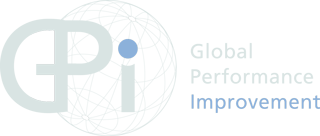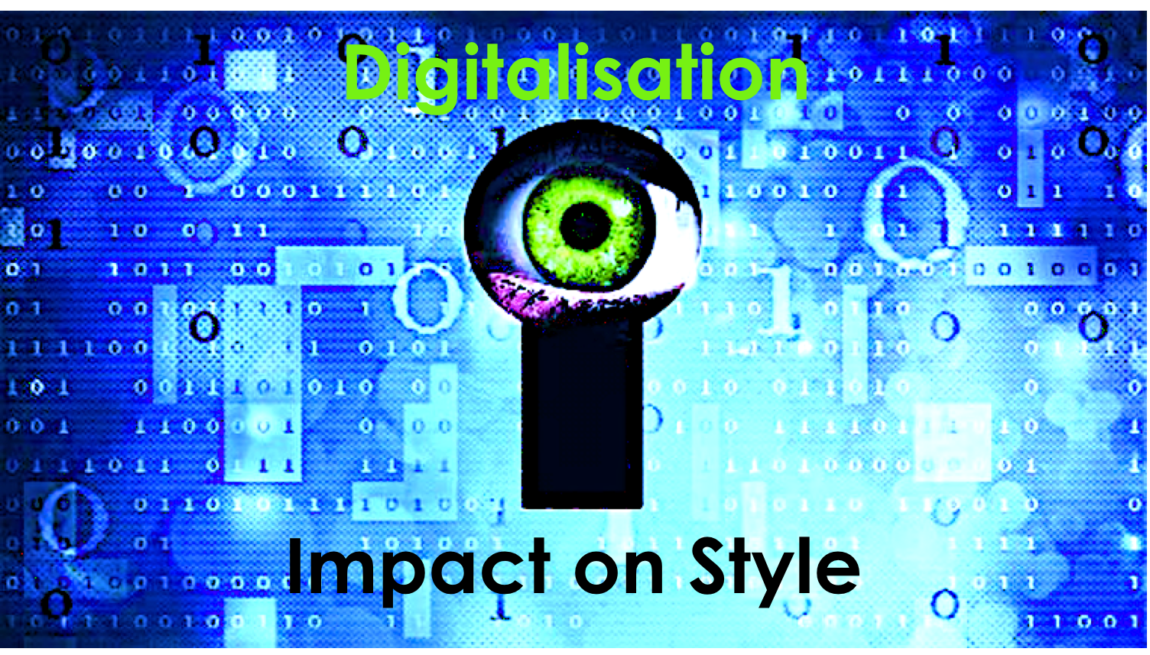
Digitalisation 2.4 – Impact on Style
This article is part of a series looking at how digitalisation affects an organisation as a whole.
The series explores how essential areas of a business are impacted and interdependent. In the previous articles we looked at the so called hard areas of strategy, structure and systems. We use the 7S model as a framework, a concept which considers all essential parts of a business. This logic is based on the premise that, for an organisation to perform well, 7 elements need to be aligned and mutually reinforcing – this video demonstrates the interdependencies. This thinking can be used to identify what needs to be (re)aligned or how to maintain alignment (and performance) during times of change. It effectively illustrates the organisational impact when managing accelerated change like digitalisation.
The bigger picture
According to a PWC report, by the year 2020, an entire generation, Generation C (for “connected”), 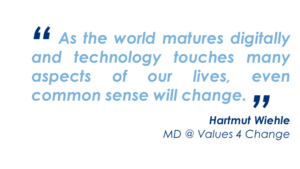 will have grown up in a primarily digital world. Computers, the Internet, mobile phones, texting, social networking are all second nature to members of this group. Their familiarity with technology, reliance on mobile communications and desire to remain in contact with large networks of family members, friends and business contacts will transform how we work and consume. This means customer’s behaviours and demands will change, and companies will have to rethink the way they do business if they want to remain on top of the game. For example, the Swedish government benefits greatly from having put digitalisation on their agenda as early as 1995. It seems like digitalisation is a must.
will have grown up in a primarily digital world. Computers, the Internet, mobile phones, texting, social networking are all second nature to members of this group. Their familiarity with technology, reliance on mobile communications and desire to remain in contact with large networks of family members, friends and business contacts will transform how we work and consume. This means customer’s behaviours and demands will change, and companies will have to rethink the way they do business if they want to remain on top of the game. For example, the Swedish government benefits greatly from having put digitalisation on their agenda as early as 1995. It seems like digitalisation is a must.
What do we mean by Digitalisation & Style
Let’s start by defining what we are talking about…
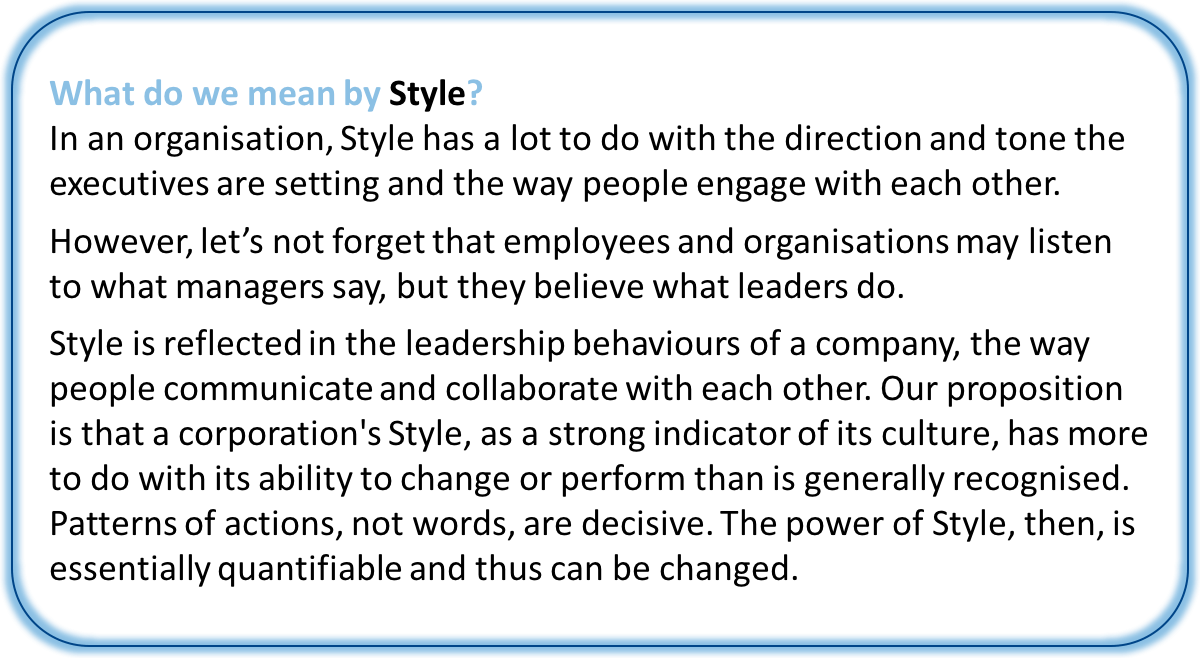
If you are interested in understanding how business culture can be defined to generate clarity and why it is important to differentiate between micro and macro viewpoint, please feel free to read the following LinkedIn article, ‘How important is measuring business culture?’
No successful digitalisation without people engagement
This article focusses on leadership, collaboration and decision-making as 3 essential aspects of Style which are key to an organisation’s digitalisation journey. These are often seen as soft topics but it’s important that people understand that no large organisation can go digital without including its people. Similarly, no rider can make an elephant move if he doesn’t entice the elephant to move. (Learn more about the elephant and the rider in “Switch. How to change things when change is hard”)
MIT’s Human Dynamics Laboratory have identified the elusive group dynamics that characterise high-performing teams – those blessed with the energy, creativity and shared commitment to outperform other teams. With modern techniques like the Pathfinder assessments, these dynamics (all people-related) are observable, quantifiable and measurable. Professor Sandy Pentland showed (HBR 4, 2012) how patterns of communication have a bigger impact on team performance than anything else! Employees can be taught how to strengthen those patterns.
Digital leadership
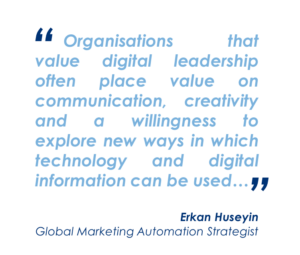 As outlined in the initial article of this series, digital leadership is the strategic use of a company’s digital assets to achieve business goals. It can be addressed at both organisational and individual levels.
As outlined in the initial article of this series, digital leadership is the strategic use of a company’s digital assets to achieve business goals. It can be addressed at both organisational and individual levels.
In this series, we are mainly interested in the latter. At the individual level, digital leadership may be carried out by the Chief Information Officer (CIO), Chief Digital Officer (CDO) or other individuals overseeing digital assets, including communication and collaboration tools. No matter the individual’s job title, an effective digital leader is always aware of corporate goals and knows how his / her own job responsibilities support these. However, as our articles are trying to show, the tactical move to have individuals or teams in charge of digital topics should only be temporary. The medium-term goal needs to be to create an organisational environment of hard and soft aspects which altogether support digitalisation. Digitalisation needs to become part of the DNA.
Leading the change
Leading is a practical set of skills used to guide other individuals, teams or organisational units. This is very relevant because organisations with the highest quality leaders are 13 times more likely to outperform their competition in key financial, quality, engagement and satisfaction metrics.
Every company in every industry will be dramatically affected by the digitalisation megatrend, and it will be the responsibility of the top teams to lead the charge by building the right capabilities for their companies to remain relevant in the digitalised environment, achieve growth and fend off competitive threats. As more businesses mature in digital capability, the ownership of digital at board and organisational level needs to shift. As pointed out by Neil Perkin, not only do more board members need to be actively involved and engaged than ever in digital, but new roles and responsibilities need to actively re-shape organisations at the highest level.
Structural influence
Leadership is strongly influenced and shaped by the organisation’s set-up and management structure. If you work in a company with 13 management levels, you will naturally experience a more hierarchical, formal leadership style defined by titles and delegating tasks downwards.
Karen Higginbottom confirmed that the type of working environment required for a digital business is not typical of the organisations in the UK. According to research from the CIPD (‘HR: Getting smarter about agile working,’ a survey of HR leaders in the UK), only 10% of organisations felt they had a dynamic structure. In fact, large organisations were more likely to be characterised by a formal, controlling environment with 46% of HR leaders in large companies identifying with this type of culture. The report revealed three main barriers to switching to a flexible, open and dynamic operating model:
- risk aversion,
- lack of trust and
- lack of a holistic approach.
As seen in the previous article there is a high demand for IT to drive forward systems which turn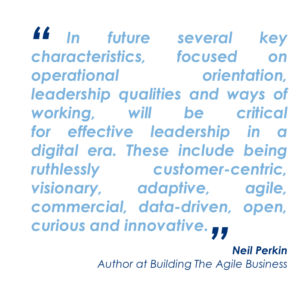 data into information. The most successful leaders of the future will be those who can effectively draw value from this insight, yet combine this with inspiring vision, creative thinking and the power to mobilise people.
data into information. The most successful leaders of the future will be those who can effectively draw value from this insight, yet combine this with inspiring vision, creative thinking and the power to mobilise people.
The right business information systems and a change in organisational set-up will allow leaders to manage by objectives whilst reviewing performance on measurable results. In a more dynamic and complex world, leaders need employees with more insight into the matter at hand. This will lead to increased delegation and the ability to ‘let go’. Therefore, leaders need to focus on direction, process and coaching their employees when they are stuck.
As matters get more complex, leaders need to empower their people to avoid being drawn into conversations and decisions they know little about. This is in line with the generational shift of a leader’s role as demographics change.
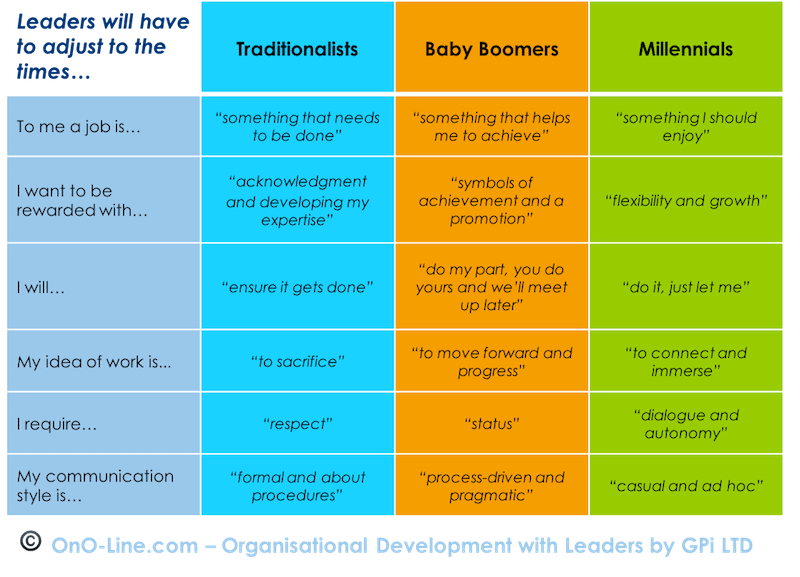
Let’s make this work together
Collaboration is a recursive process where two or more people work together to realise shared goals; the extent to which people come together, share viewpoints, engage and create varies.
In many larger companies employees operate within the strict boundaries of their role. They have clear working procedures which define with whom and when to engage. I think many places have gone too far in limiting people’s autonomy. Equipped with a clearly defined job description, a slot in the linear process, a checklist and decision-making tools, it is no surprise modern technologies can so easily replace their jobs.

What we are left with is supposedly clear interfaces when employees hand over tasks. However, as complexities and dynamics increase, frustration levels rise. This is because employees either stick to the role and let things unravel, or take matters in their own hands to get things under control. In this situation, it is important that leaders do not punish employees for stepping out of line but rather try to understand why.
Furthermore, personal contacts and informal networks enable cross-organisational cooperation in many firms. They would be well advised to trust their employees and build on this.
As discussed in the article on structure, companies need to break down silos and encourage cross-functional collaboration. The ‘new model of IT’ in the systems article illustrates this well. People led by objectives, with the autonomy to get there, measured by results and engaging with colleagues or teams when and where necessary – that is what companies should aim for. More flexible IT solutions will quickly adapt and provide people with shared data and decision-making tools.
Decision-making
Decision-making can be regarded as a problem-solving activity. It focusses on the interaction of employees trying to come up with a decision and the outcome.
Traditionally we find hierarchical, top-down decision-making power with relatively clear, rule-based practices in place. When matters get more complicated, experts are called in. Decisions affecting the entire organisation need to come straight from the top to be implemented. Such a slow decision-making process risks jeopardising promising careers or initiatives. Decisions are often made when there is a high level of certainty and when risk-minimisation can be applied.
However, as companies enter more unchartered and dynamic terrain, the speed and quality of decisions become mission-critical. On the one hand, modern technology can help accelerate processes with automation but, on the other hand, a more complex world is opening up. You may be familiar with the term ‘VUCA’. It comes from the U.S. Army War College and stands for a more Volatile, Uncertain, Complex and Ambiguous world. A world of big data analytics where disruption is standard, game-changing technologies and global dynamics influence local markets, millennials take on leadership positions, and customer needs change regularly.
As a consequence, defining right or wrong becomes increasingly difficult. 2008 was the first time we added ‘dilemma management’ to an executive leadership development programme. I think this mix of personal attributes and skills has become even more relevant since then.
Companies need to react to this more challenging world in two ways:
- From the outside
Everything should start with the customer. This is not about the usual clichés you read on most corporate websites. Let your employees engage with key customers to understand what they think.
Agree, with your people, measurable goals that will boost their individual performance. Create a level of transparency and access to rational data which will enable them to make more entrepreneurial decisions.
- From the inside
Spell out your values and set them as guidelines. Providing leaders and employees with clearly ranked values, helping them understand how these translate into behaviours and obtaining their true buy-in enables them to make judgment calls when facing a dilemma. More on ‘Shared Values’ and value-based leadership in the final article coming up in this series.
People generally need more freedom. Most of us can make difficult decisions in our personal lives, so why not embrace this ‘everyday’ ability at work?
Conclusion
Style is just one aspect of digitalisation, but it is a crucial one. As things develop and get more uncertain, business leaders will more than ever rely on their people’s willingness to make things happen. Leadership starts at the top and leaders need to realise they are the catalysts for change. They are also role models so authenticity is key.

The VUCA world is only going to increase in intensity. Companies need to start finding ways of turning this into Vision, Understanding, Clarity and Agility. Interestingly enough, digital solutions can be a great enabler.
The organisational structure is key if you want to change leadership and people’s behaviours. Individual roles and departments with a digital transformation remit should only be a temporary solution. Digitalisation is a mindset which should be embedded throughout the organisation.
Modern leaders act more authentically, instil trust and have higher retention rates. You need to develop their digital skills as well as their personal attributes like openness, curiosity and resilience. As complexities increase, leaders need to be able to coach stuck employees.
 Collaboration needs to intensify and freedom to increase to encourage experimentation, swift decision-making and, most importantly, continuous learning.
Collaboration needs to intensify and freedom to increase to encourage experimentation, swift decision-making and, most importantly, continuous learning.
Standard decision-making processes will be simplified from an individual perspective. As we are entering a time of more challenging decisions, people need clarity and tangible facts that speak to the mind but also a value-based approach that enables gut feelings and intuition.
In all cases leaders are there to encourage this new working style, provide feedback and create an atmosphere of trust and ‘we are in this together’ – because we are.
With a more incremental approach to strategy, a flatter, more nimble structure, systems that empower employees and develop the right mindset, companies will not only adapt to rapid changes but flourish.
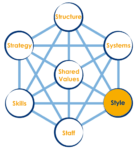 To see how we integrated the 7S into what clients call a “clever and game-changing approach” when assessing business units and teams, please try our Pathfinder Freemium version.
To see how we integrated the 7S into what clients call a “clever and game-changing approach” when assessing business units and teams, please try our Pathfinder Freemium version.
Additionally, watch this short clip to see how STYLE fits into the bigger picture. If you are interested in finding about more, please feel free to get in touch with me because I am genuinely interested in connecting with people who also want to explore what is coming our way and what do with it.
